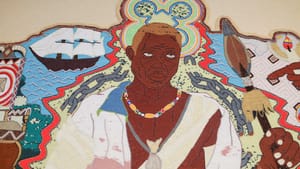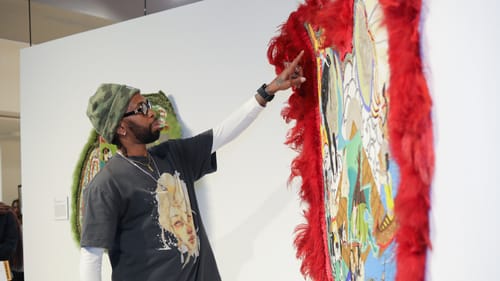Stay in the Loop
BSR publishes on a weekly schedule, with an email newsletter every Wednesday and Thursday morning. There’s no paywall, and subscribing is always free.
Preserving culture, one bead at a time
The African American Museum in Philadelphia presents Demond Melancon: As Any Means Are Necessary

Demond Melancon writes the history of his people in glass beads. Intricate and colorful portraits, masks, and Mardi Gras suits by the New Orleanian are the subject of Demond Melancon: As Any Means Are Necessary, at the African American Museum in Philadelphia.
Though his work has been shown around the world, Melancon, 46, didn’t set out to be an artist: his aim was to march as a Mardi Gras Indian on the streets of the Lower Ninth Ward, to be part of the 200-year tradition of Black Masking, in which elaborately costumed warriors compete in ceremonial battles in a statement of identity, pride, and ancestral resistance. The practice developed in response to oppression and grew from New Orleans’s confluence of West African, Afro Caribbean, and Indigenous cultures.
Crescent City quilting bees
Members work year-round to prepare for carnival season, which culminates on Mardi Gras. Costumes, or suits, must be conceived, designed, and sewn, and marches practiced, which takes not only time but money. It’s a labor of love, but Black Maskers also have to make a living. Melancon, who’d been “second-lining” since he could walk, following the brass bands, poured concrete and worked in kitchens while learning the craft and heritage of masking from “Big Chiefs” who lead Black Mask groups, known as “tribes.”
By age 14, Melancon was learning to sew. His designs became increasingly detailed and incorporated glass beads, his chosen medium. In 2012, the Big Chiefs rewarded Melancon’s dedication and talent, giving him a tribe to lead and welcoming him into their fold as Big Chief of the Young Seminole Hunters. Red Cloud and Sitting Bull (2013), the first suit Melancon wore as a chief, is on view. Rimmed in bright red feathers, it’s dominated by beaded profiles of the Lakota warriors who resisted US government encroachment on their territory and freedom.

“I try to bring all of my blessings back to my community and to my culture, because we need to be seen,” Melancon said in a documentary about his work. “This is a serious culture that’s been hidden.” The film depicts the effort that members put into masking, and the fellowship they share. It shows burly men sitting in a backyard, hunched around a canvas, sewing—the Crescent City version of a quilting bee. It depicts how suits are fitted to wearers, with elders making sure younger members are properly turned out and ready to strut.
The Indigenous connection
Black Masking is an assertion of existence and a celebration of endurance. It’s also an acknowledgement of the alliance between enslaved Black people and the Indigenous peoples who helped them escape and evade capture, reflected in terms such as Mardi Gras Indians, tribes, and big chiefs.
Typically, Blask Mask suits take both design and subject matter from Native American garments, but Melancon’s suits also incorporate African and African American themes. For instance, Bras-Coupé (2016) depicts Squire, an enslaved man known to have danced in New Orleans’s Congo Square.
Squire’s enslaver amputated his right arm after an escape attempt (bras-coupé means cut-arm). Undaunted, Squire tried again and succeeded, becoming the focus of a relentless police search. Though not recaptured, Squire was murdered in 1837, becoming a legend among the enslaved and an indelible part of New Orleans lore. Melancon’s depiction surrounds him with symbols of enslavement and freedom: a sailing ship, a fiery railroad track, a hand grasping a lit candle. Squire, at center, is solemn, his golden eyes raised in pain. Though his right arm is nothing more than a bandaged stump, Squire’s left arm ends in the cuff of a broken chain, swinging free.
Avocation to art form
Suit aprons cover the waist to ankles, and can measure as much as 50 inches across. The space seems even larger when the beads covering it measure just 2.1 millimeters in diameter (there are about 25 millimeters in an inch).
Bead colors and textures are as varied as daubs of paint on a palette. Each bead must be speared from a wooden bowl with the tip of a needle and slid onto a beeswax-lubricated thread, then sewn to the canvas. Imagine doing that a million times over, imagine it taking 4,000 studio hours to create impactful visual narratives, and you understand Melancon’s evolution from devoted marcher to renowned artist.
In 2017, Melancon’s lifelong pursuit became his career. He entered the contemporary art world and remains one of the few practitioners to work in glass beads. He was recognized in 2024 with the Gibbes Museum and Society 1858 Prize for Contemporary Southern Art. As Any Means Are Necessary, organized by Halsey Institute of Contemporary Art at South Carolina’s College of Charleston, is his first solo museum exhibition.
“Opening doors that’s never been opened”
The exhibit includes newer work by Melancon based on masks of the Ashanti people of modern Ghana, and a portrait series depicting personal heroes, among them an Egyptian queen (Nefertari, Queen of Peace, 2024), Tina Turner (Proud Mary, 2024), Cicely Tyson (Just As I Am, 2022), Stevie Wonder (Soul a Burning Fire, 2024), Sir Elton John (Reggie Hercules, 2023), and art collector Marguerite Guggenheim (Style & Grace, 2023), all exquisitely rendered in tiny beads.

The artist and his wife and co-creator, Alicia Melancon, spend long hours in the studio, fabricating images of people and events that can’t be forgotten. Their workroom, recreated in the exhibit, is decorated with figures who inspire Melancon: portraits of victims who activated Black Lives Matter protests; a tapestry of Ethiopian Emperor Haile Selasse I, who sought to modernize his country in a 44-year reign; and a rug replicating an IKEA receipt by designer Virgil Abloh (1980-2021), whose meteoric career was cut short by cancer.
Wherever Melancon’s art takes him, his creative purpose has not changed. “I do art because we’re opening doors that’s never been opened … When I finish this suit,” he said recently, “it’ll take every Big Chief in this city about a hundred years to catch me. That’s what it’s supposed to be about … you can’t beat me with my needle and thread. The message that I’m trying to relay with this suit? Here to knock down the White House walls.”
What, When, Where
Demond Melancon: As Any Means Are Necessary. Through July 27, 2025, at the African American Museum in Philadelphia, 701 Arch Street, Philadelphia. (215) 574-0380 or aampmuseum.org.
Accessibility
AAMP is a wheelchair-accessible venue.
Sign up for our newsletter
All of the week's new articles, all in one place. Sign up for the free weekly BSR newsletters, and don't miss a conversation.
